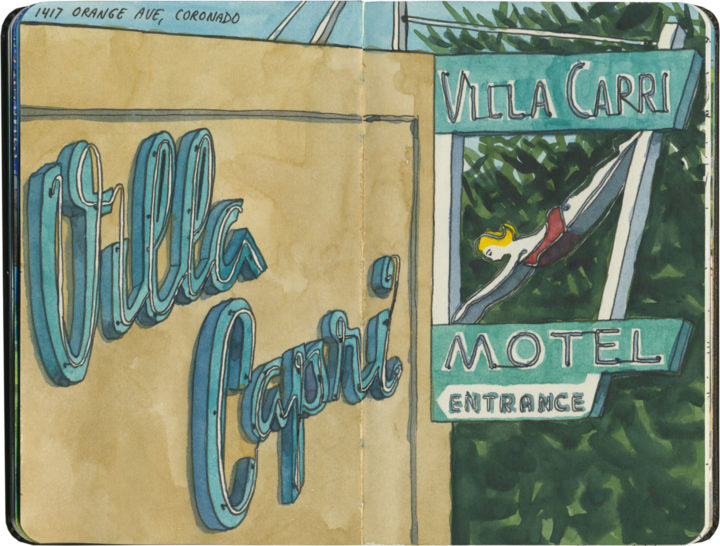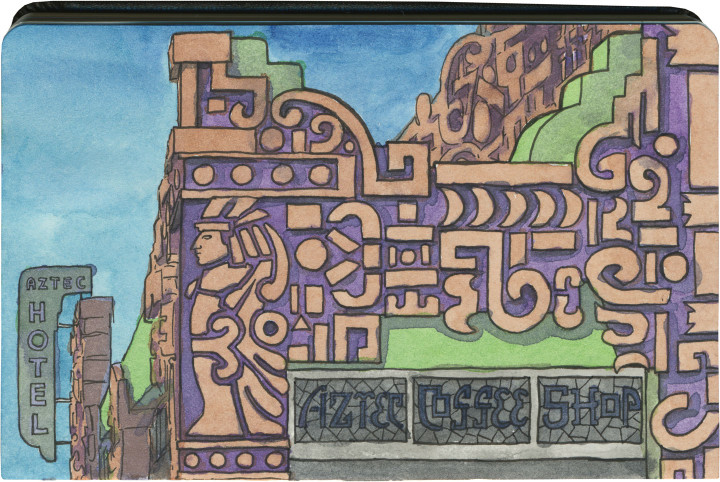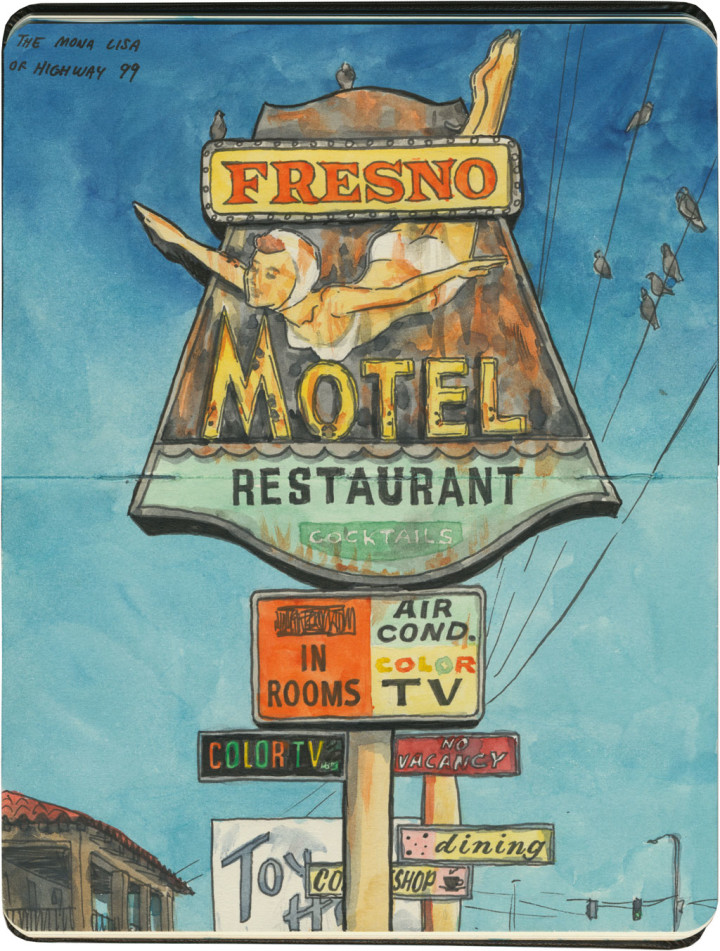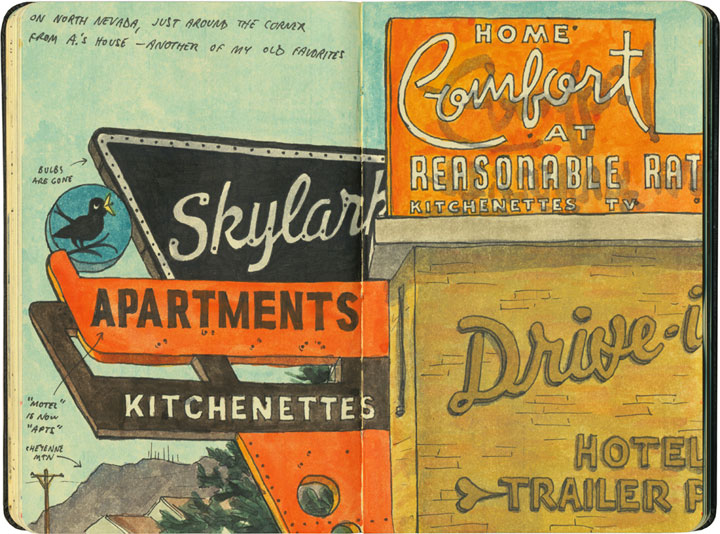Now, unlike the Wagon Wheel Motel on Route 66, I haven’t stayed here, so can’t vouch for the place as a whole. But its spiffy new paint job and its place on my other favorite historic highway give it a permanent place in my heart, nonetheless.


Now, unlike the Wagon Wheel Motel on Route 66, I haven’t stayed here, so can’t vouch for the place as a whole. But its spiffy new paint job and its place on my other favorite historic highway give it a permanent place in my heart, nonetheless.

I didn’t do a ton of traveling in 2016—all my adventures last year took place in the Pacific Northwest (and that’s fine with me!). Sticking close to home ended up being a necessity, as well, what with improvement projects around our 95-year-old house, and massive, years-long projects occupying me in the studio.
I have no idea what’s in store for 2017, or how much travel or sketching I’ll be able to squeeze in. I hope it’s lots, though, because I have big plans. I’m ready to dive into the new year—how about you?
Wishing you a happy, healthy, safe and successful 2017!

This post is part of an ongoing series called 66 Fridays, which explores the wonders of old Route 66. Click on the preceding “66 Fridays” link to view all posts in the series, or visit the initial overview post here.
Most of the must-see treasures of Route 66 are individual landmarks or legends: Meramec Caverns, the Oatman burros, the Gemini Giant. But one of the most important stops along the way is an entire town. Welcome to Tucumcari: Googie oasis of yore, midcentury Cibola of 2000 motel rooms.
Today’s Tucumcari is somewhere halfway between worlds, simultaneously a time machine and a crumbling architectural ruin. To me it felt the way it would to visit Pompeii, only to find the city still inhabited. This is the place where, much like the stretch of 66 through Albuquerque, you can find rusted neon masterpieces everywhere you look—
—except here, the neon is equally likely to mark a still-operating motel as a defunct one.
Yet while the town’s pulse still keeps a beat, that mythical number of motel rooms has diminished somewhat.
I’m sure the motels aren’t the only ones—for every business still standing, I had to wonder how many had disappeared.
Still, Tucumcari seems to take pride in its place along Route 66. Take the famous Tee Pee Curios (no, I didn’t misspell my sketch; the building uses both spellings at once!), which remains one of the most documented attractions of the Mother Road.
Sadly, I didn’t get inside, as we rolled in to town too late the night before, and we had to leave before it opened for the day. Still, it was good to see the place in such fine fettle, new coat of paint and all.
But that’s okay: the real gem of Tucumcari, and perhaps the crown jewel of all of Route 66, was where I got to devote my time. The Blue Swallow is the perfect symbol of Tucumcari: still alive, still authentic, still beautiful.
The night we spent at the Blue Swallow was the one we’d been looking forward to the most on that trip, because we just needed proof that there were still places like this left on the planet. As soon as we crossed the threshold to our room, we knew the place was in good hands.
It was like stepping into 1939. The place was meticulously authentic (not to mention spotlessly clean and bright). Whatever wasn’t actually original to the room (and almost all of it was) was carefully restored to the correct period—right down to the 1939 Bell rotary-dial phones. Heck, even the price of the room was a total throwback.
For me, at least, the Blue Swallow was incredibly comfortable. Maybe it’s because I live in an old house with old furnishings and old fixtures, but I just felt right at home. Anyway, this is the sort of thing I want on a road trip like this. I would have been incredibly sad if we’d opened that door to find the plaster replaced with drywall or a huge flat-screen TV taking up one wall. As it was, I nearly cried from relief to find things just as they were from the beginning.
Places like the Blue Swallow and towns like Tucumcari are an endangered species. American culture, in general, prefers the new and novel to the historic—the freeway to the meandering path. That’s why it’s such a miracle that there’s any Route 66 left to enjoy at all. For every vintage motel that manages to keep thriving with each passing year, another closes its doors. And that’s why it’s going to take all of us to keep these places alive.
Still, whatever the future might hold, I’m glad to see there’s still a beating heart in Tucumcari tonite.

This post is part of an ongoing series called 66 Fridays, which explores the wonders of old Route 66. Click on the preceding “66 Fridays” link to view all posts in the series, or visit the initial overview post here.
Compared to some of the other outrageous neon specimens along Route 66, this one seems downright pedestrian. Still, there’s a kind of midcentury perfection to this one, from the gorgeous script lettering to the jaunty lightning bolt through “TV.” And there’s something familiar about the shape of the sign, as well, as if one had seen it before…
Ah, right. One has. This brighter, showier version is just fifty miles away in Lebanon, MO—it was built (by the same neon company, no less) in tribute to the Rest Haven sign, which the owner of the Munger Moss had admired when it was erected just a year or so before, in 1953. And both signs are a clear homage to one of the most famous neon sign designs in America: the one known simply as the “Great Sign,” which began marking Holiday Inns around the U.S. in ’52.
I’m guessing there wasn’t a whole lot of respect for intellectual property among sign scribes of the time, because this sort of design pilfering was pretty common—but I find I just can’t get too riled up about this case. For one thing, that basic Great Sign look appeared in knock-offs all over the country—clearly people thought if it ain’t broke, don’t fix it. For another, I confess I felt a little thrill when I got to see that little TV lightning bolt again: it was like a moment of Deja Googie.

This post is part of an ongoing series called 66 Fridays, which explores the wonders of old Route 66. Click on the preceding “66 Fridays” link to view all posts in the series, or visit the initial overview post here.
Here’s a unique one. If you drive Route 66 through the seemingly unending sprawl of greater Los Angeles, you’ll pass an ornate oddment around the halfway point of the Valley. The place is called the Aztec Hotel, and it’s apparently one of the best (and only) still-standing examples of Mayan-Revival architecture.
Did you know that was a thing? Me, neither.
Nevermind that the Aztecs and Mayans were two completely different cultures, and the implications of approximating either or both in America—whatever your opinion of the genre, the Aztec Hotel’s unique relief work is quite a beauty. And amazingly, the “Mayan” style dovetails beautifully with the Art Deco era in which this place was built.
The Aztec is currently closed, but rumor has it that the building is owned by a Chinese investor, who is supposedly fixing the place up with plans to reopen in the near future. I really hope that’s the case, because based on vintage photos I’ve seen of the interior, I’m dying to get in there with my sketchbook.

This post is part of an ongoing series called 66 Fridays, which explores the wonders of old Route 66. Click on the preceding “66 Fridays” link to view all posts in the series, or visit the initial overview post here.
If you want to see a good concentration of neon signage you can visit the Miracle Mile in California, or you might try 11th Street in Tulsa. Or you just can head straight for the Googie Mecca. I gave you just a taste of it in last week’s installment, but I figured it was worth elaborating a bit.
There are actually two Route Sixty-Sixes in Albuquerque, as the Mother Road’s path changed from a north-south route to an east-west one. (That’s a story in and of itself, which I’ll tell in a future post.) And both alignments of the old highway are absolutely crammed with vintage neon.
Central Avenue is the more recent incarnation of 66, cutting roughly a fifteen-mile neon swath through the heart of the city.
Googie beacons point the way from the eastern boundary…
…to the far western edge of town. At the peak of Route 66’s heyday in the mid-1950s, there were apparently 98 motels along Central Avenue—yet even in 2015 I lost count of how many old signs we passed.
The Mother Road signage isn’t limited to lodging, either.
Many of the signs were in fine fettle, either newly restored or lovingly maintained. Still, we passed business after business that had very recently been shuttered for good—a reminder that the Route 66 Mom-n-Pop is an endangered species.
About fifteen or twenty years ago, stretches of Central Avenue and its motel relics were plagued with the hallmarks of hard times: drugs, violent crime, human trafficking. Yet in recent years the remaining business owners have made an effort to clean up the thoroughfare and their properties, particularly from Nob Hill inward.
The contemporary result is example after gleaming example of gorgeous storefronts and restored midcentury typography.
I just couldn’t believe our luck—we’d hit the Googie jackpot.
There wasn’t time to finish even a single sketch that day—it was all I could do to keep up by jotting down messy, temporary pencil scrawls. The “To Finish in the Studio Later” debt I incurred that day was enormous, and I’m still paying it off. I haven’t even showed you everything here—just my favorites (oh, that canary Cleaners storefront! A sketch will never do that beautiful, pristine façade the justice it deserves).
So, yeah. I loved Albuquerque already, for other reasons, but Route 66’s mark on the city pushed it into the stratosphere for me. The only downside is that now the bar has been raised a goodly height—and at least where old neon is concerned, it’ll be hard to find anywhere else that can hold a candle to the Q.

When Mary-Alice and I hatched our Florida trip earlier this year, I made a point of not planning any destinations ahead of time. I wanted to be surprised by what we found along the road. One of the many surprises that day was crossing the famous “Swanny”.
An even better surprise (for me) was what was waiting for us on the opposite bank.

If you’re into neon signs or period architecture, Fresno is something of a wonderland. But truth be told, I planned this entire leg of my trip around this sign alone. I mean, look at her! She might have seen better days, but to me she’ll always be a masterpiece.

Vernal is the known as the gateway to Dinosaur National Monument. And don’t get me wrong, I’m always game for a national park—but I would have come all that way just to see the pink concrete dinosaur. (Priorities, right?)

Just like the neighboring town of Manitou Springs, Colorado Springs is filled with midcentury neon signs and fabulous Googie lettering. This sign is one of my very favorites. It’s been altered a bit over the years, but the fact that a relic like this still exists in a town that’s changing and expanding at a rapid pace—well, it feels like a bit of a miracle to me.